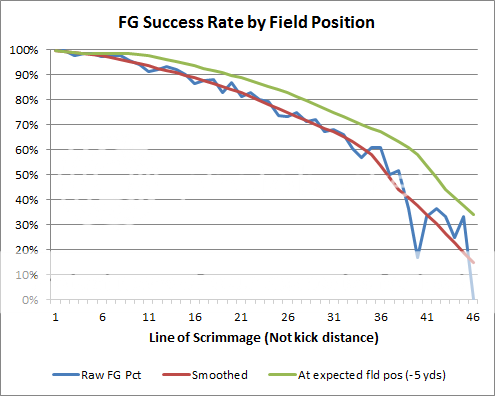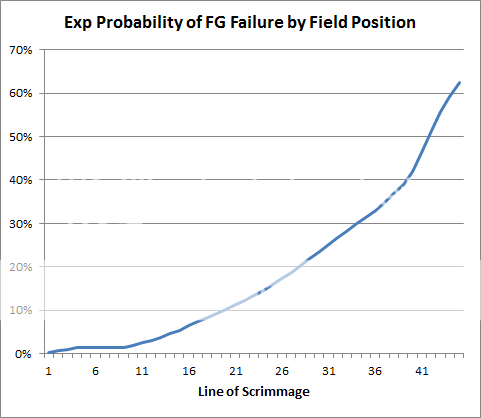This is the third part of a five-part post on when an intentionally allowed TD is preferable to forcing a FG in the endgame. The first two parts of the post laid out the analysis and assumptions, and estimated the time remaining when the team on defense would get back possession. This installment looks at the probability of an unsuccessful FG attempt to take the lead.
Field Goal Success Probability
The simplest way to win for a defense caught in the field goal choke hold is to pray for an unsuccessful FG attempt. This is a mostly straightforward calculation but has a couple wrinkles. The success rates here include all possible causes of a FG ultimately being unsuccessful. That includes blocks, botched snaps, and even penalties that force longer attempts which turn out unsuccessful.
Also, as mentioned previously, an estimate of the expected field position on 4th down is required. For now, I will say that the offense will gain 5 yards during its 1st, 2nd and 3rd down plays. This is essentially a plausible placeholder for now, and a more detailed analysis can be done to confirm or adjust this.
The graph below shows three things. The jagged blue line is the actual raw FG success rate by line of scrimmage. (Add 17 or 18 yards for the commonly used 'kick distance'.) The red line is the estimated true probability of success. This estimate was computed non-parametrically, using locally weighted regression. The green line is the same curve as the red line, but offset 5 yards closer to the uprights. (Inside the 10, the 5 yards are progressively curtailed.)
But what really matters is the inverse of the chart above. What we care about is the expected probability of failure, that is, one minus the probability of success. The chart below provides a different perspective, emphasizing how the FG failure rates dramatically increase with range.
The final two parts of this post will look at the probabilities of a responding scoring drive (part 4) and will present the final results of when a defense would prefer to allow a TD to forcing a FG (part 5).
- Home
- win probability
- When to Intentionally Allow a Touchdown, Part 3
When to Intentionally Allow a Touchdown, Part 3
By
Brian Burke
published on 12/10/2012
in
research,
strategy,
win probability
Subscribe to:
Post Comments (Atom)











Interesting read. It is particularly frustrating as a fan of the game watching coaches make such dubious decisions with the game on the line.
While waiting for the exciting conclusion of part 5, I started thinking about the scenario with the forced FG that misses. Have you considered the possibility that the offensive team that is trailing and missing a FG may still have timeouts of its own to use? For example, the defensive team stops the offense and uses all three timeouts, leaving 2:20 on the clock. The offensive team misses the FG, but has three timeouts of its own. The original offensive team can force a punt and get the ball back with just under two minutes to go in this scenario, which is plenty of time to get back into FG (attempt) range again.
No. Honestly, I ignored that possibility. But as you'll see in the dramatic, nail-biting conclusion, there aren't many realistic scenarios where that would come into play. But that's not so say it's impossible.
Excellent point. That's something I'll have to wrestle with in the next refinement.